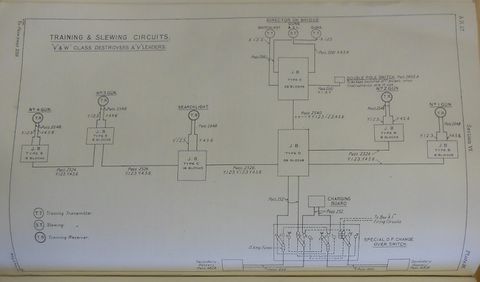Parker Class Flotilla Leader (1916): Difference between revisions
| Line 91: | Line 91: | ||
[[File:ARTS1917Plate100.jpg|thumb|480px|'''Firing Circuits'''{{ARTS1917|Plate100}}]] | [[File:ARTS1917Plate100.jpg|thumb|480px|'''Firing Circuits'''{{ARTS1917|Plate100}}]] | ||
[[File:ARTS1917Plate101.jpg|thumb|480px|'''Training and Slewing Circuits'''{{ARTS1917|Plate101}}]] | [[File:ARTS1917Plate101.jpg|thumb|480px|'''Training and Slewing Circuits'''{{ARTS1917|Plate101}}]] | ||
In 1917, it was approved that all flotilla leaders except {{UK-Swift}} and {{UK-Abdiel}} should receive installations of the [[British Destroyer Director Firing System]],{{ARTS1917|p. 229}} though no installations of this equipment were completed prior to 1918,{{UKProgressInNavalGunnery1914-1918|p. 37}} and a source from 1920 indicates that the ''Parkers'' had not received theirs | In 1917, it was approved that all flotilla leaders except {{UK-Swift}} and {{UK-Abdiel}} should receive installations of the [[British Destroyer Director Firing System]],{{ARTS1917|p. 229}} though no installations of this equipment were completed prior to 1918,{{UKProgressInNavalGunnery1914-1918|p. 37}} and though a source from 1920 indicates that the ''Parkers'' had not received theirs,{{UKTHVol4Part34|p. 17}} the 1918 handbook on the destroyer director system indicates the surviving units had them.{{UKDirectorFiringDestroyers1918|p. 55}} | ||
Additionally, the ''Director Firing Handbook, 1917'' reports that they had [[Small Type Training Receiver]]s of pattern number 20 on #1, #2 and #3, and pattern number 21 on #4.{{DirectorH|p. 146}} | |||
===Torpedo Control=== | ===Torpedo Control=== | ||
Revision as of 17:26, 18 July 2014
The six flotilla leaders of the Parker Class were completed in 1917.[Fact Check]
| Overview of 6 vessels | |||||
|---|---|---|---|---|---|
| Citations for this data available on individual ship pages | |||||
| Name | Builder | Laid Down | Launched | Completed | Fate |
| Grenville | Cammell Laird | 17 Jun, 1916 | Dec, 1931 | ||
| Parker | Cammell Laird | 16 Aug, 1916 | 5 Nov, 1921 | ||
| Hoste | Cammell Laird | 16 Aug, 1916 | Collision 21 Dec, 1916 | ||
| Saumarez | Cammell Laird | 14 Oct, 1916 | 8 Jan, 1931 | ||
| Seymour | Cammell Laird | 31 Aug, 1916 | 7 Jan, 1930 | ||
| Anzac | Denny | 11 Jan, 1917 | 8 Aug, 1935 | ||
Machinery
Generators
In 1916, it was stated that flotilla leaders have two 26.25 kw dynamos arranged in parallel with an additional 9 kw oil-fired set for emergency use.[1] It is fairly likely that this applied to this earlier class.
Armament
Guns
- four 4-in Q.F. Mark IV guns on P. IX mounting.[2]
Torpedoes
- Two double revolving 21-in torpedo mounts[Citation needed]
In 1917, at least some of these ships were using 21-in Mark II***** torpedoes.[3]
Fire Control

By the end of 1915, it was planned that all but Anzac at least were to be provided a range and order data system like that then being given to the "M" class destroyers and to the Faulknor class leaders.[5]
The scheme placed the combined transmitter on the forebridge, and a combined receiver near the sightsetter position of each gun. Ranges from 0 to 9900 yards in increments of 100 yards, and orders were "Independent", "Control" and "Fire" with illuminated indicators and a red indicator on the receivers to signal loss of power from the battery pack located below decks.
Directors


In 1917, it was approved that all flotilla leaders except Swift and Abdiel should receive installations of the British Destroyer Director Firing System,[8] though no installations of this equipment were completed prior to 1918,[9] and though a source from 1920 indicates that the Parkers had not received theirs,[10] the 1918 handbook on the destroyer director system indicates the surviving units had them.[11]
Additionally, the Director Firing Handbook, 1917 reports that they had Small Type Training Receivers of pattern number 20 on #1, #2 and #3, and pattern number 21 on #4.[12]
Torpedo Control
In mid-1920, it was decided that all these ships except Anzac should each receive a Renouf Torpedo Tactical Instrument Type A.[13] A year later, the allocation was increased to include Anzac.[14]
Alterations
By November 1918, Seymour (only), operating with the Eleventh Destroyer Flotilla, was fitted to carry 40 "H" and "M" type mines. The torpedo tubes and guns removed when the mines were shipped could be placed back aboard with enough notice.[15]
See Also
Footnotes
- ↑ Annual Report of the Torpedo School, 1916. p. 120.
- ↑ Director Firing For Flotilla Leaders and Destroyers. p. 55.
- ↑ Annual Report of the Torpedo School, 1917. p. 61.
- ↑ Admiralty. Handbook of Fire Control in Torpedo Boat Destroyers of "M" Class and Later and Flotilla Leaders, 1915, Plate XIV.
- ↑ Admiralty. Handbook of Fire Control in Torpedo Boat Destroyers of "M" Class and Later, and Flotilla Leaders, 1915, p. 3, Plate XIV.
- ↑ Annual Report of the Torpedo School, 1917. Plate100.
- ↑ Annual Report of the Torpedo School, 1917. Plate101.
- ↑ Annual Report of the Torpedo School, 1917. p. 229.
- ↑ Progress in Naval Gunnery, 1914-1918. p. 37.
- ↑ The Technical History and Index, Vol. 4, Part 34. p. 17.
- ↑ Director Firing For Flotilla Leaders and Destroyers. p. 55.
- ↑ The Director Firing Handbook. p. 146.
- ↑ Annual Report of the Torpedo School, 1919. p. 119.
- ↑ Annual Report of the Torpedo School, 1920. pp. 90-1.
- ↑ Admiralty. Annual Report of the Torpedo School Mining Appendix, 1917-1918, p. 11. Plate 7.
Bibliography
- March, Edgar J. (1966). British Destroyers: A History of Development, 1892-1953. London: Seeley Service & Co. Limited. (on Bookfinder.com).
| Parker Class Flotilla Leader | |||||||||||||||||||||||||||||||||||||||||||||||||||||||||||||||||||||||||||||||||||||||||||||||||||||||||||||||||||||||
| Grenville | Parker | Hoste | |||||||||||||||||||||||||||||||||||||||||||||||||||||||||||||||||||||||||||||||||||||||||||||||||||||||||||||||||||||
| Saumarez | Seymour | Anzac | |||||||||||||||||||||||||||||||||||||||||||||||||||||||||||||||||||||||||||||||||||||||||||||||||||||||||||||||||||||
| <– | Lightfoot Class | Destroyer Leaders (UK) | "V" Class | –> | |||||||||||||||||||||||||||||||||||||||||||||||||||||||||||||||||||||||||||||||||||||||||||||||||||||||||||||||||||